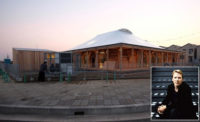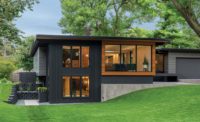When Susanne Pertl, a board member at the Stern Stewart Institute in Munich, first saw the work of Diébédo Francis Kéré, she knew he would be the ideal architect for an organization that promotes education and entrepreneurship in West Africa. Kéré had grown up in a remote village in Burkina Faso before earning his architecture degree in Germany and opening an office in Berlin. Today, Kéré remains committed to his home country, where he has completed such projects as the Center for Health Care and Social Promotion in Laongo (RECORD, August 2015) and a high school in Dano (RECORD, January 2011).
“I found Kéré’s architecture to be extraordinary,” says Pertl. “The buildings are not ‘monuments,’ but look special and work well for their inhabitants.” The organization ultimately commissioned Kéré to design Lycée Schorge (named for a Pertl family member), a secondary school encompassing 17,900 square feet—the architect’s largest completed building to date.
The school opened last February, on the fringe of Koudougou, a city in Burkina Faso with 132,000 residents. Featuring local materials, natural ventilation, a modern design vocabulary—and constructed by workers who live in the area—the building embodies the qualities found in Kéré’s other Burkinabe projects. It also introduces new stylistic yet functional elements: “I’m constantly experimenting with local building materials in innovative and modern ways,” the architect explains.
Given its rampant poverty, meager resources, and brutal heat, Burkina Faso is a challenging canvas for any designer. The architecture of the mostly undeveloped, landlocked nation is dominated by simple concrete structures and mud huts. Kéré’s first project there, a primary school in his native village completed in 2001, garnered international attention. Since then, he has worked tirelessly across the country to create dignified and low-cost architecture that responds to its context.
Lycée Schorge does just that. Situated on a flat swath of semi-arid land, the school consists of nine distinct rectangular volumes arranged radially around a courtyard. Taking cues from traditional villages, the plan protects the outdoor gathering space from wind and dust while also providing a sense of privacy. The modules, each 900 square feet, contain classrooms and offices, along with a dental clinic.
To construct the school’s walls, Kéré used red-hued bricks made of laterite, a subterranean soil that hardens when exposed to air. “It has a high thermal mass, plus a beautiful color and a porous, textured surface,” he says. The masonry facades are punctuated with tall, unglazed windows covered with colorful metal shutters, which bring light and air into the building. Curved seating units made of thin wood members are affixed to the window casings and appear to merge with the shutters.
The school’s exterior is wrapped by a distinctive screen made of eucalyptus, a fast-growing tree that is typically used for scaffolding and firewood. Here it is used for a brise-soleil. “I wanted to give this material a more powerful and sustainable purpose,” says Kéré about the enclosure, which shades patios and walkways.
When it came to designing the corrugated steel roof, the architect employed one of his signature strategies. Using trusses of rebar, he raised the roof high above the building envelope, enabling hot air to easily escape the interior. Its deep overhangs also mitigate solar heat gain. To further enhance the indoor climate, Kéré added a series of angular, 8-foot-high concrete wind towers that capture fresh air and funnel it downward. The undulating ceilings are made of gypsum fiberboard, straw, and cement mortar. Long slits in the cream-colored surfaces allow the classrooms to breathe and expel heat while ushering in diffused daylight.
Kéré also designed the furniture, with local craftsmen making hundreds of chairs and desks using salvaged construction material, such as plywood and rebar. The Philadelphia Museum of Art, which staged a solo exhibition of Kéré’s work in 2016, recently added one such chair to its permanent collection.
By all accounts, the school has made a powerful impact. “I cried when I saw it,” says Pertl, noting that a building of lower quality wouldn’t have been as effective. “This landmark shows our students that we want them to work hard, dream big, and achieve great goals.” The facility is also beloved by its pupils, who tend to linger long after classes have ended for the day. “The students are happy to see that the design is different from other schools,” says Baslayi Tindano, a biology and gardening teacher. “It inspires them to excel and make a difference.” Kéré, who vividly recalls sitting in cramped, dark, and sweltering classrooms as a child, credits the client for the school’s success.
“If you have a client who is open to innovation,” he says, “you are able to do great things.”










